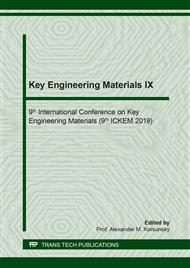[1]
Davidovits, J. (1991). Geopolymer: inorganic polymeric new materials. Journal of Thermal Analysis and Calorimetry. 37, 1633-1656.
Google Scholar
[2]
McLellan, B. C., Williams R. P., Lay J., Riessen A. V. and Corder G. D. (2011). Cost and carbon emissions for geopolymer pastes in comparison to ordinary Portland cement. Journal of Cleaner Production. 19, 1080-1090.
DOI: 10.1016/j.jclepro.2011.02.010
Google Scholar
[3]
Vargas, J. and Halog A. (2015). Effective carbon emission reductions from using upgraded fly ash in the cement industry. Journal of Cleaner Production. 103, 948-969.
DOI: 10.1016/j.jclepro.2015.04.136
Google Scholar
[4]
R.H. Abdul Rahim et al. (2015). Comparison of Using NaOH and KOH Activated Fly Ash-Based Geopolymer on the Mechanical Properties,, Materials Science Forum. 803, 179-184.
DOI: 10.4028/www.scientific.net/msf.803.179
Google Scholar
[5]
Li, X., Wang, Z., and Jiao, Z. (2013). Influence of curing on the strength development of calcium-containing geopolymer mortar. Materials. 6, 5069-5076.
DOI: 10.3390/ma6115069
Google Scholar
[6]
Chindaprasirt, P., Chareerat, T., and Sirivivatnanon, V. (2007). Workability and strength of coarse high calcium fly ash geopolymer. Cement and Concrete Composites. 29, 224-229.
DOI: 10.1016/j.cemconcomp.2006.11.002
Google Scholar
[7]
Kusbiantoro, A., Rahman, N. and Shahedan, N. F. (2015). Interrelationship Analysis of Geopolymer Components using Pearson Correlation Technique. Applied Mechanics and Materials. 567, 417-421.
DOI: 10.4028/www.scientific.net/amm.567.417
Google Scholar
[8]
van Deventer, J. S. J., Provis, J. L., Duxson, P., and Lukey, G. C. (2007). Reaction mechanisms in the geopolymeric conversion of inorganic waste to useful products. Journal of Hazardous Materials. 139, 506-513.
DOI: 10.1016/j.jhazmat.2006.02.044
Google Scholar
[9]
Rahman, N., Kusbiantoro, A., Muthusamy, K., and Abdullah, M.M.A. (2015). Degree of Reaction and Alkali Leaching of Geopolymer Containing Ca-Rich Source Material and Dipotassium Hydrogen Phosphate. Key Engineering Materials. 765, 275-279.
DOI: 10.4028/www.scientific.net/kem.765.275
Google Scholar
[10]
American Society of Testing and Materials. (2013). Standard Test Method for Density, Absorption, and Voids in Hardened Concrete. Philadelphia, ASTM C642.
Google Scholar
[11]
Carabba, L., Manzi, S., and Bignozzi, M. C. (2016). Superplasticizer addition to carbon fly ash geopolymers activated at room temperature. Materials. 9(7), 586.
DOI: 10.3390/ma9070586
Google Scholar
[12]
Lloyd R. R. Provis J. L. and van Deventer J. S. J. (2010). Pore solution composition and alkali diffusion in inorganic polymer cement. Cement and Concrete Research. 40, 1386-1392.
DOI: 10.1016/j.cemconres.2010.04.008
Google Scholar
[13]
Najafi, E. K., Allahverdi, A. and Provis, J. L. (2012). Efflorescence control in geopolymer binders based on natural pozzolan. Cement and Concrete Composites. 34, 25-33.
DOI: 10.1016/j.cemconcomp.2011.07.007
Google Scholar
[14]
Metha, P. and Paulo, J. M. Monteiro. (2005) Concrete: Microstructure, Properties and materials. Third Edition. Mc Graw Hill.
Google Scholar
[15]
Palomo, A., Grutzeck, M. W., Blanco, M. T. (1999). Alkali activated fly ashes a cement for the future. Cement and Concrete Research. 29, 1323-1329.
DOI: 10.1016/s0008-8846(98)00243-9
Google Scholar
[16]
Yahya, Z., Abdullah, M. M. A., Hussin, K., Ismail, K. N., Razak, R. A., Sandu, A. V. (2015). Effect of solids-to-liquids, Na2SiO3-to-NaOH and curing temperature on the palm oil boiler ash (Si + Ca) geopolymerization system. Materials. 8, 2227-2242.
DOI: 10.3390/ma8052227
Google Scholar
[17]
Abdulkareem, O. A., Abdullah, M. M. A., Hussin, K., Ismail, K. N., Hussain, M. (2013). Mechanical and microstructural evaluations of lightweight aggregate geopolymer concrete before and after exposed to elevated temperatures. Materials. 6, 4450-4461.
DOI: 10.3390/ma6104450
Google Scholar
[18]
Kusbiantoro, A., Ibrahim, M.S., Muthusamy, K. and Alias, A. (2012). Development of sucrose and citric acid as the natural based admixture for fly ash based geopolymer. Procedia Environmental Sciences. 17, 596-602.
DOI: 10.1016/j.proenv.2013.02.075
Google Scholar
[19]
Sokol, E. V., Kalugin, V. M., Nigmatulina, E. N., Volkova, N. I., Frenkel, A. E. and Maksimova, N. V. (2002). Ferrospheres from fly ashes of Chelyabinsk coals: chemical composition, morphology and formation conditions. Fuel. 81, 867-876.
DOI: 10.1016/s0016-2361(02)00005-4
Google Scholar
[20]
Sindhunata, van Deventer, J. S. J., Lukey, G. C., and Xu, H. (2006). Effect of curing temperature and silicate concentration on fly ash based geopolymerization. Industrial & Engineering Chemistry Research. 45, 3559-3568.
DOI: 10.1021/ie051251p
Google Scholar


